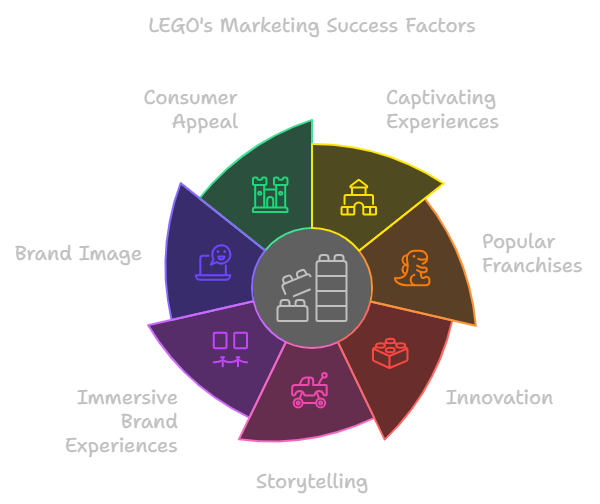LEGO Set Profits: How Big Are They?
LEGO sets have been popular for a long time. Both kids and adults love them. But have you ever thought about how much money these colorful building blocks make? You might be surprised by the answer.
In this article, we will talk about the profits made by LEGO sets. We will also see how big they are. Get ready to be amazed by the impressive numbers behind these favorite plastic bricks!
Overview of LEGO’s Revenue Streams
![]()
LEGO makes most of its money by selling construction sets. These sets are the most significant way the company earns profits. They have pieces from different lines and themes that appeal to many customers. The company’s various series and set sizes affect its earnings and how much money it makes.
For example, smaller sets with unique themes, like LEGO Ideas and Seasonal, have increased profits when resold. LEGO’s range of products has helped it get a big part of the market. Also, LEGO has partnered with popular franchises like Star Wars and The Simpsons to boost sales and increase the value of its brand. These partnerships have brought in a lot of money for the company. LEGO’s focus on different products and partnerships with well-known brands has significantly made more money and improved its financial performance.
Analysis of Diverse LEGO Product Portfolio

LEGO offers a variety of products that help bring in revenue. This includes LEGO Ideas, Seasonal, and Super Heroes series, which have all been successful with customers. These products attract different types of buyers, as shown by the popularity of LEGO Ideas from 2010-2014, LEGO Seasonal (2006-2014), and LEGO Super Heroes (2011-2014). By constantly releasing new and unique products, LEGO focuses on innovation and sustainability.
The company’s wide range of products has helped it stay profitable in the long run. On average, unopened sets make an 11 percent profit each year, with different levels of success depending on the set size and series. This solidifies LEGO’s position as a leading brand in the toy construction industry. The company’s dedication to innovation and sustainability has played a big part in its ongoing success and financial stability.
Impact of Strategic Initiatives on LEGO’s Bottom Line
Strategic initiatives have significantly boosted LEGO’s profits. Product innovation and entering new markets have been significant factors in the company’s revenue growth. Launching new product lines and reaching out to new demographics has increased LEGO’s market share and profits. Marketing strategies like partnerships and brand collaborations have also been significant. Collaborations with popular franchises and celebrities have increased LEGO’s brand visibility, customer engagement, and sales.
LEGO’s focus on sustainability and educational programs has positively affected its financial performance. These initiatives have enhanced the company’s brand image and increased customer loyalty and sales.
LEGO’s Commitment to Future Generations
Factors Contributing to LEGO’s Profit Growth
LEGO’s profit growth can be linked to several factors. One key factor is the company’s marketing and promotional strategies. Their aggressive advertising, social media campaigns, and partnerships with popular movies and franchises have increased brand visibility and sales. Also, diversifying their product range has boosted overall profitability. Offering a wide range of products, from smaller sets to elaborate collectibles, has helped them reach a broader customer base.
Additionally, tapping into specific series such as LEGO Ideas, LEGO Seasonal, and LEGO Super Heroes has increased resale profit margins and reinforced their position as a toy industry leader.
Examination of LEGO’s Marketing Strategies

LEGO’s marketing strategies have boosted its profit growth. The company focuses on releasing sets that offer captivating experiences for different audiences, keeping the demand high. Leveraging popular movie franchises and character series has boosted brand recognition and consumer appeal.
LEGO’s collaborations with global entertainment franchises maintain a strong presence in the toy industry. Its marketing strategies emphasize innovation, storytelling through product design, and creating immersive brand experiences. Constantly developing new and exciting building sets attracts both existing and new consumers.
LEGO’s storytelling aspect, vibrant building set designs, and appeal to children of all ages set it apart. The company’s strategies have also enhanced its brand image and consumer reputation. By positioning itself as a premium and trustworthy brand focused on quality, creativity, and educational value, LEGO has gained a loyal consumer base and steady profit growth.
Preliminary Insights into LEGO’s Earnings
Economists Victoria Dobrynskaya and Yulia Kishilova found several factors contributing to LEGO’s profit growth. The resale of unopened construction sets yields an average profit of 11 percent per year. The size and series of the set are influential, with some sets yielding from -50 to up to 600 percent in profit. Smaller sets with up to 350 pieces are the most profitable, with an average profit margin exceeding 22 percent.
Regarding product series, LEGO Ideas, LEGO Seasonal, and LEGO Super Heroes have reported high average resale profits of 51 to 64 percent.
Favorable economic evaluations and market volatility don’t significantly influence LEGO set profitability. LEGO investments yield higher profits than other collectible assets like art pieces, precious stones, metals, and rare coins. The analysis indicates that LEGO’s overall profitability is influenced by the set’s size, series, and the market demand for specific themes.

Vizologi is a revolutionary AI-generated business strategy tool that offers its users access to advanced features to create and refine start-up ideas quickly.
It generates limitless business ideas, gains insights on markets and competitors, and automates business plan creation.


